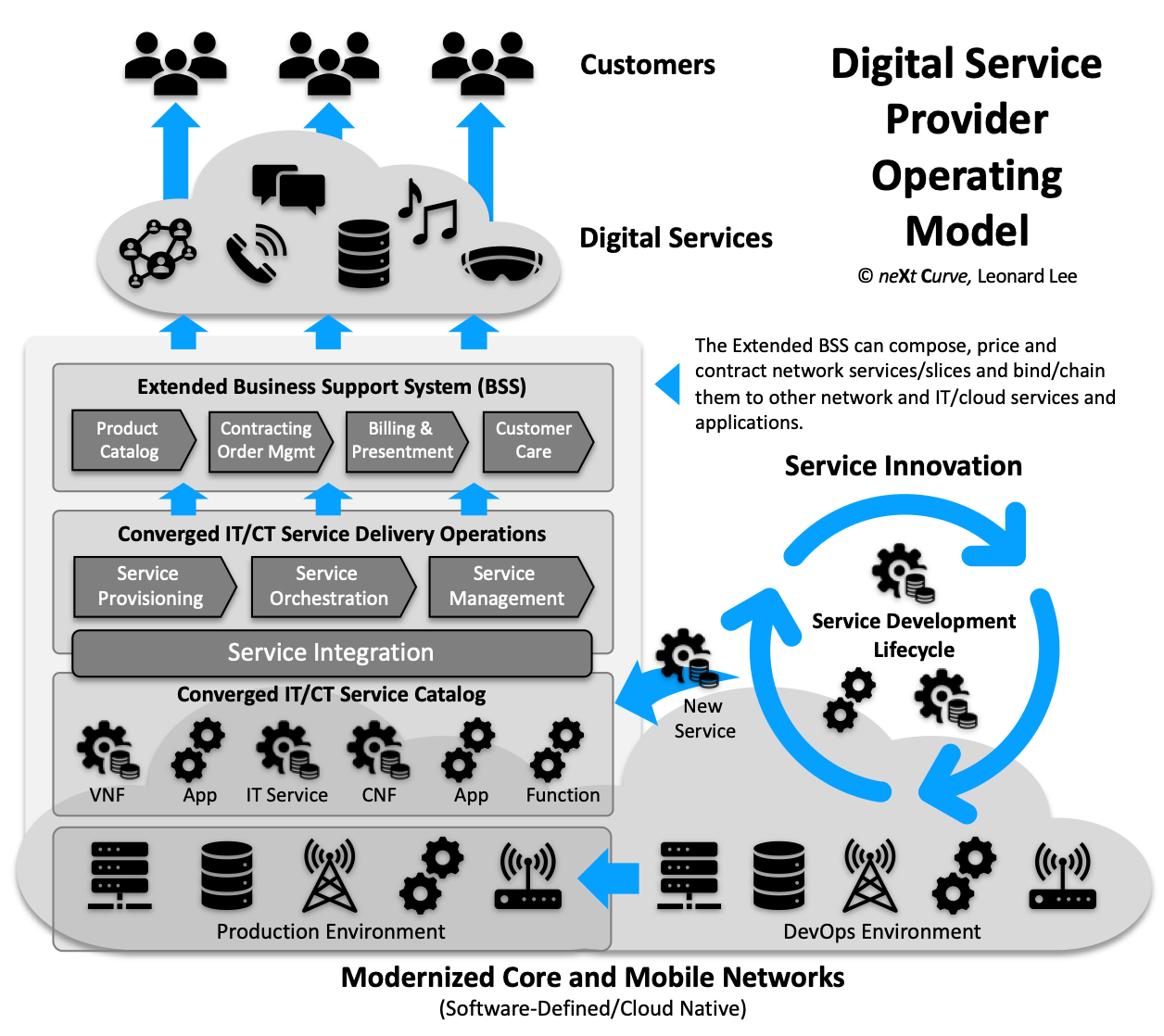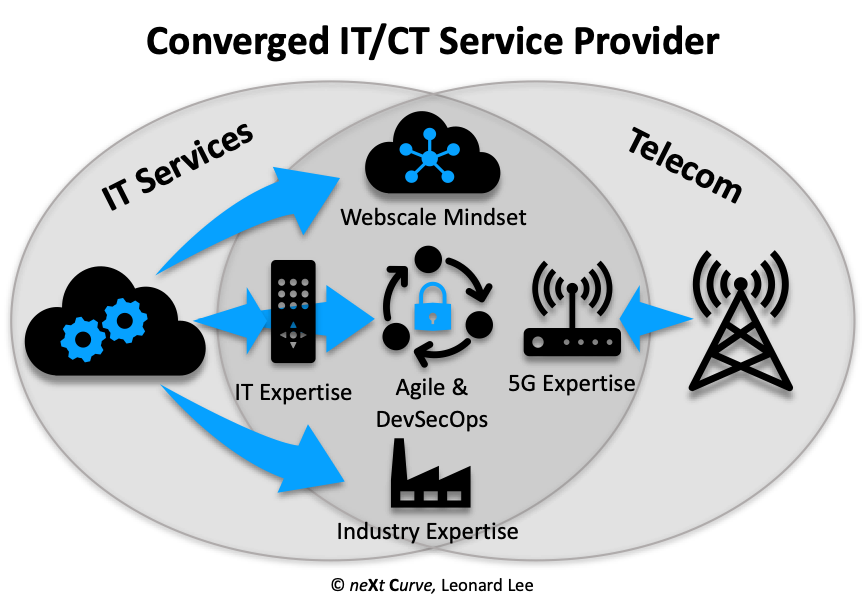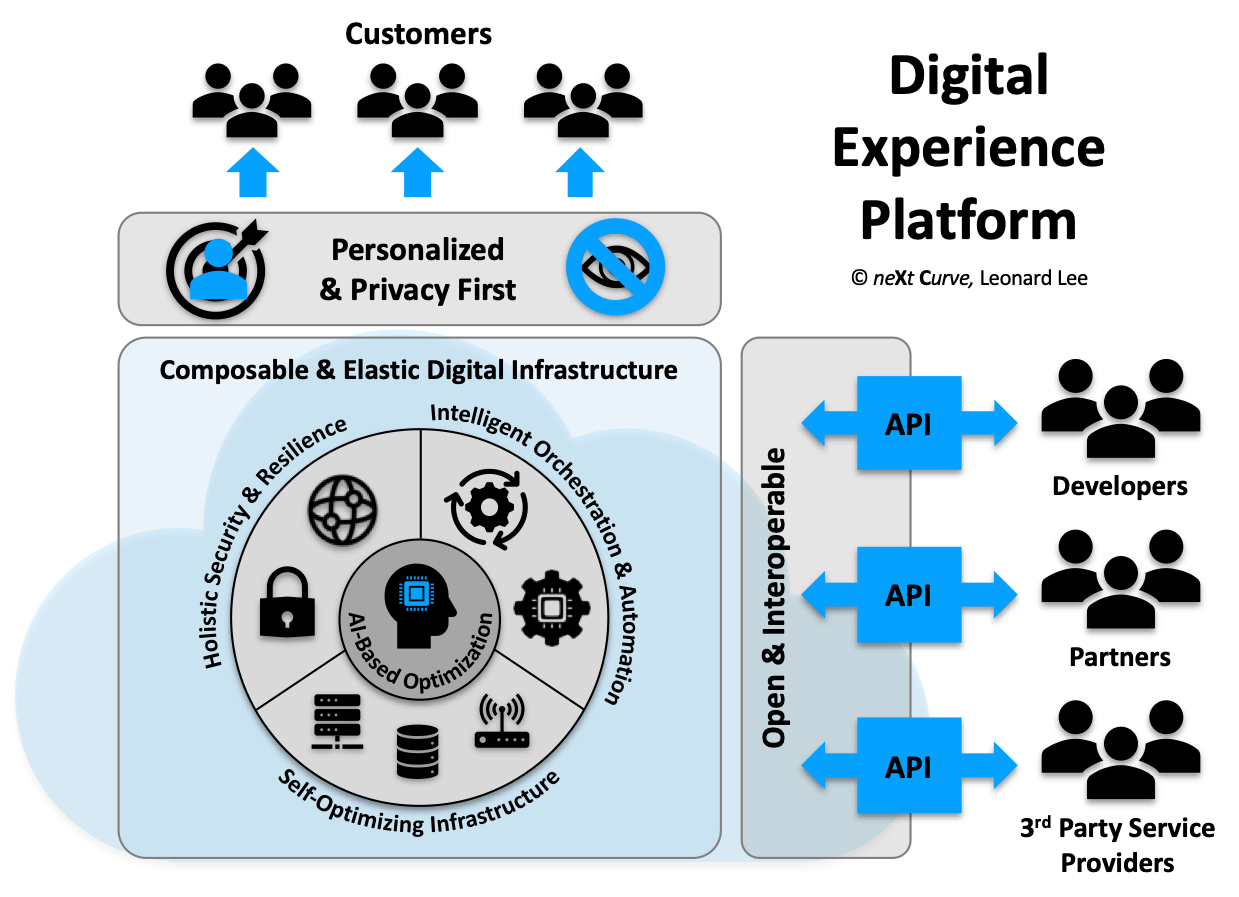Since the term “Cloud Computing” was coined, CSPs (Communications Service Providers) have had a tremendous challenge developing viable cloud capabilities and offerings for their enterprise clients that can compete with emerging digital infrastructure players such as Amazon Web Services and Microsoft Azure. With 5G on the horizon it is ever more critical that traditional telco operators find their cloud mojo lest current cloud leaders and new intermediary entrants make a move to the middle to take the great 5G promise away from them.
In May of 2017, Verizon sold its struggling cloud and managed hosting business to IBM. Verizon is far from the only CSP to throw in the enterprise cloud towel. Carrier cloud is a vast battleground littered with the bodies of operators that have struggled to make a dent in the armor of the Big Two – Amazon’s AWS and Microsoft’s Azure. In the emerging era of 5G, CSPs are once again faced with the threat of becoming OTT’ed as public cloud players begin to eye frontiers beyond the data center – Edge Computing. Just imagine Amazon converting a section of a Whole Foods into a central office that hosts converged IT/CT cloud infrastructure services closer to the Edge – scary.
Fortunately, CSPs have been in the business of connecting businesses and households to the last mile which positions them well to capitalize on computing’s move toward the Edge. The IBM and Vodafone deal represents a compelling step toward what neXt Curve believes is a critical collaboration between an enterprise technology firm and a telecommunications company in taking important first steps in realizing new, converged IT/CT services that are delivered across the emerging 5G network. It might seem like telcos are revisiting this strategy. After all, Verizon tried to add cloud services onto their network with the acquisition of Terremark in 2011, but that project didn’t pan out as hoped. What is different this time around?
4G and 5G – That Was Then, But This is Now
A foundational transformation that 5G brings to the telecom industry is the virtualization of the entire network – core and mobile. That means network functions are abstracted and software-defined allowing for an elastic, composable infrastructure that can be configured and fine-tuned for the specific needs of an application or workload via network slicing.
As the network becomes more “cloud”-like, it is converging with the compute and storage cloud thanks to open source and consortia standards such as OpenStack, Kubernetes (container management & orchestration) and OpenFog, which are collectively promoting the integration and blurring of IT (Information Technology) and CT (Communications Technology) into what we at neXt Curve call converged IT/CT. This is the big difference between 4G era and the coming 5G era.
While there is overwhelming fanfare and hype about how 5G will transform our lives, another transformation must take place before the world can reap the benefits of 5G – telco transformation. There are few things that telcos must do to position themselves to capitalize on converged IT/CT opportunities in the coming age of 5G.

- Modernize Core and Mobile Networks – When most of us think of 5G we think of the mobile network and 5GNR (New Radio). We tend to treat lightly the core network and the importance of modernizing (virtualizing and software-defining) the entire network. CSPs will need to commit to the robust aspiration of digitizing the network to realize the cost-efficiencies and the enablement of new service revenues that will drive the return on their investment in 5G.
- Revamp Service Delivery Operations – CSPs need to transform the culture and practices of their service delivery operations and organizations to become more IT-like through the adoption of webscale operational practices and a new service-oriented mindset. This transformation is less about DevOps and Agile than it is about adopting ITSM (IT Service Management) principles that are geared toward delivering and managing cloud-based converged IT/CT services.
- Extended Business Support Systems (BSS) – CSPs need to figure out how to sell, provision, bill and present new converged IT/CT services that are delivered over the 5G network cloud. A new, extended BSS platform will be vital in enabling CSPs to quickly go to market with new 5G services that will be dynamically-optimized blends of network, compute and storage/persistence services, and to rapidly configure and deploy new revenue models.
- Service Innovation – CSPs need to adopt a different mindset in their product and service development and borrow from IT disciplines of Agile development and DevSecOps as their production infrastructure becomes increasingly virtualized, software-defined and continuous-delivery capable.
Symbiotic Relationship in the Making
IT consultancies and systems integrators like IBM have a decades-long history working with CSPs on their “digital transformation” endeavors. Partnering together with operators in the development and delivery of converged IT/CT services can be a powerful symbiotic relationship that addresses the challenges that both CSPs and traditional IT firms face today – CSPs need IT and vertical market expertise, and IT firms need tight integration with the new 5G network cloud to deliver the next-generation, ubiquitous computing solutions to their enterprise clients.

There are a number of key synergies that CSPs and IT firms can pursue in reinventing the network and ushering in the next evolutionary stage of cloud computing:
- Webscale Mindset – With years of managing hosted services at scale many IT firms bring deep experience in operating software-defined assets in delivering cloud-based IT services to enterprise clients. Some of these IT firms are supporting the digital transformation of CSPs and are ideal coaches on organizational, operational and business model change.
- Agile and DevSecOps Culture – Since the advent of cloud computing, IT firms have adopted Agile and DevSecOps practices and culture in the way that they operate and deliver new IT services and applications to their customers. CSPs that partner with IT firms can learn and adopt these practices to foster continuous delivery and accelerate service innovation.
- Technical Expertise – By partnering with an IT firm, CSPs can leverage the technical knowledge and experience in IT needed to design, implement and operate a new converged IT/CT platform and infrastructure. Conversely, IT firms gain deep integration with 5G fixed and mobile network infrastructures upon which new converged IT/CT services can be delivered with intelligence and optimized value.
- Vertical Industry Expertise – An increasing number of IT firms are developing or have developed robust industry-savvy consulting groups that can work with CSP product development teams in designing compelling converged IT/CT offerings that address the ubiquitous computing needs of a vertical market.
A New Platform, A New Infrastructure for A New Era of Computing
The key outcome of this symbiotic collaboration between CSPs and IT firms should be a new Digital Experience Platform that is an integrated, distributed stack of network and IT services running on an intelligent 5G network and across the Cloud Continuum.
Why “Experience”? The new 5G networks will provide an elastic, composable and finely-tunable infrastructure of connectivity that will be expected to deliver high performance with consistency (QoS), reliability, resiliency, availability and coverage to meet the requirements of some of the hypothetical killer applications that lead the 5G promise such as autonomous vehicles and remote surgery.

The Digital Experience Platform will likely emerge with the following key attributes:
- Open and Interoperable – Built on open standards and frameworks such as OpenStack and designed to be interoperable as converged IT/CT applications will need to be deployed and consumed across different networks and environments.
- Ecosystem-Friendly – Supports converged IT/CT application development and service management environments and tools that are easy to use and foster the engagement of developer and service management communities.
- Composable & Elastic Digital Infrastructure – A cloud-based infrastructure that provides fine-grained virtualization of network and compute functions and resources that can be configured and deployed elastically to meet the real-time requirements of an application or workload.
- Intelligent Service Orchestration & Automation – Algorithmically orchestrates converged IT/CT services across the network and automates service management operations based on context and events.
- Self-Optimizing Infrastructure – Leverages predictive analytics and machine learning to continuously tune the converged IT/CT infrastructure to deliver optimal service quality across data centers and edge nodes.
- Holistically Secure & Resilient – Provides contextually-aware security up and down the converged IT/CT stack and from endpoints to applications to bare metal.
- Personalized & Privacy First – Designed with personalization features that are compliant with established and emerging privacy regulations such as GDPR, and provides safeguards and consumer controls.
The realization of this Digital Experience Platform may be exactly what CSPs need to stave off the growing OTT (Over-The-Top) threats from Amazon (Nokia partnership), Google (Google Fiber), Facebook (Nokia fixed wireless partnership) and Microsoft (Redline Communications partnership), all of which have some form of converged IT/CT play in the works or are dabbling in core telecommunications services and infrastructure.
Implications for Business and Technology Leaders
5G is not just about the lofty promises of faster broadband service, near-zero latency and massive device connections. For CSPs, 5G is an opportunity to reinvent their business and their industry. The future of digital infrastructure is not just about connectivity. It is about IT and CT working together in concert to create and enable new industrial and consumer applications – market opportunities. The network will need to be tuned dynamically and fine-grained services matched with the bespoke needs of each individual compute workload across a converged IT/CT cloud that spans from the data center to the small cell. What new value can CSPs create in enabling ubiquitous, intelligently distributed and orchestrated computing? This is the big question and challenge for today’s beleaguered telecommunications industry.
It will be important for business leaders who are leading the future of CSP organizations to consider and pursue strategic partnerships with systems integrators and IT consultancies to accelerate the development of vertical industry solutions and converged IT/CT capabilities and services that will make high-value 5G and IoT use cases possible today and in the future. Highly-motivated IT services partners can bring the IT acumen and the cross-industry experience that many CSPs sorely lack. What better catalyst for driving the massive reinvention journey that CSPs will need to undergo as we push forward into a future of 5G and transformative IoT applications? Old dogs working together maybe able to figure out some new trick to win in our digital future.
For more insights on neXt Curve’s Converged IT/CT and 5G Evolution research themes contact us for a detailed briefing with one of our analysts. Follow our site to get updates and notifications of our research and our 2019 research agenda.
Related Content & Media
- Market Insights: IBM+Red Hat, The Great Cloud Brokerage Play
- 5G Americas Analyst Forum 2018: Key Takeaways
- The Democratization of 5G Everything
- Market Insights: Time Warner – AT&T’s Killer App
- Contextually-Aware Mobile Security as a Service: The Key to IoT Security and GDPR Compliance & Readiness with Blockchain
- The Future of Cloud
by
Leonard Lee
Managing Director, neXt Curve
January 22, 2019
This material may not be copied, reproduced, or modified in whole or in part for any purpose except with express written permission or license from an authorized representative of neXt Curve. In addition to such written permission or license to copy, reproduce, or modify this document in whole or part, an acknowledgement of the authors of the document and all applicable portions of the copyright notice must be clearly referenced.
© 2019 neXt Curve. All rights reserved.
16 comments